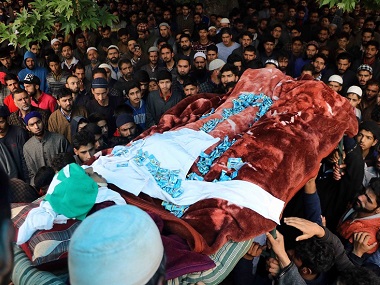Pinjoora: Umar Ahmad Kumar had just returned from school when blaring loudspeakers in the mosques of Pinjoora, his native place, urged people to come out and “save the militants” trapped in Turkawangam village, nearly 11 kilometres away, where a brief encounter with the security forces started on Thursday afternoon. Umar, 15, dropped his school bag and dashed into the kitchen where his mother was preparing dinner. According to the family, he promised her that he will return soon. Umar was the youngest among 15 persons who travelled in three Tata Sumo taxis to the village, in a bid to save the trapped militants. “When they reached Darazpora village, forces started firing and chased them away. They left the taxis and crawled into an orchard. Everyone was crawling, except for him. He was shot and died on the spot,” Gulzar Ahmad Kumar, elder brother of Umar, told Firstpost at their home late on Thursday. [caption id=“attachment_4456017” align=“alignnone” width=“825”] People carry the body of teenager Umar Ahmad Kumar in Pinjoora village of Shopian district on Thursday. Image courtesy Hilal Shah[/caption] Kumars are traditional Kashmiri chefs who prepare the much-cherished Wazwan feast. This is the second tragedy to hit the family in two years. Umar’s father, Mohammad Ashraf Kumar, died on 9 November, 2016, leaving a big family without much financial support. The elder brother, Gulzar, took the care of his family. According to locals and police sources, among the militants reportedly trapped at the encounter site was Zeenat-ul-Islam Shah, one among the twenty most wanted militant commanders in the Valley today. He managed to escape from the site, just like he did on 1 April, near his village at Dragad Sugan, along with four of his associates. Seven of his Hizbul Mujahideen associates were killed in the encounter. After a brief exchange of firing at army vehicles patrolling the area, the militants fled. But the troops assumed that the attackers had taken shelter in residential houses at Turkwagan village. At the site of the encounter, on 2 May, a charged mob of young boys and men turned so violent that forces had to retreat after the civilian casualty. The cordon-and-search-operation (CASO) started on Wednesday evening but forces had to call it off after trapped militants, believed to be three to five in number, escaped under the cover of stone-pelters. In the initial firing, a subedar-major of the army was wounded. He was shifted to the army’s 92 Base Hospital in Srinagar for treatment. Soon afterwards, the forces were surrounded on all four sides by protesters who threw stones and whatever they could lay their hands on. The forces fired live ammunition, pellets and teargas shells, resulting in the death of Umar, while 30 others were injured. That a 15-year-old student in school uniform died for the survival of a 30-year-old militant is a new normal in Kashmir. Surprisingly, there is no remorse. Men bravely talk about their new ‘martyr’ while the womenfolk are wailing in a makeshift tent. There is anger but not a feeling of loss, neither among Umar’s friends nor relatives, and not even the family members. [caption id=“attachment_4456019” align=“alignnone” width=“825”]
 Umar Ahmad Kumar’s sister with his school uniform. Image courtesy Hilal Shah[/caption] “We were four brothers. One was martyred today. Now, we are only three,” Gulzar said plainly in an emotionless voice while describing the killing of his brother. As he was narrating Umar’s story, his mother fainted in the tent and the women raised a hue and cry. The elder son shouted: “Su hai gov shaheed, ti wyen kath chu wadun? (He died a martyr, then why are you crying?).” Umar has become one of nearly three dozen civilians killings in recent times, which have continued unabated in the Valley. In the first four months of this year, 114 people have died in the militancy-related violence. The dead include 53 militants, 33 civilians, 14 policemen, 13 army men and a political worker.
Umar Ahmad Kumar’s sister with his school uniform. Image courtesy Hilal Shah[/caption] “We were four brothers. One was martyred today. Now, we are only three,” Gulzar said plainly in an emotionless voice while describing the killing of his brother. As he was narrating Umar’s story, his mother fainted in the tent and the women raised a hue and cry. The elder son shouted: “Su hai gov shaheed, ti wyen kath chu wadun? (He died a martyr, then why are you crying?).” Umar has become one of nearly three dozen civilians killings in recent times, which have continued unabated in the Valley. In the first four months of this year, 114 people have died in the militancy-related violence. The dead include 53 militants, 33 civilians, 14 policemen, 13 army men and a political worker.
According to official data, 41 people including 16 civilians, 19 militants, four army men, a policeman and a political worker were killed in April alone, one of the bloodiest months recorded in many years.
“We are sitting on a volcano of anger,” CPM leader and MLA Kulgam Mohammad Yousuf Tarigami, told Firstpost. “These senseless killings will haunt us all as we witness this dance of death. It is painful to see teenage boys risking their lives to save militants. But why do they do that is something we all have to understand. And we all understand it.” On Thursday morning, thousands of people participated in the funeral of the teenage boy. His mother wrapped the shroud on his son’s body and as mourners carried the coffin, women sang songs celebrating his ‘martyrdom’ while showering candies on it. As the dead body was taken for burial, Umar’s grieving sister came out with his school uniform and placed it on the body; both men and women cried at this sight.


)

)
)
)
)
)
)
)
)



